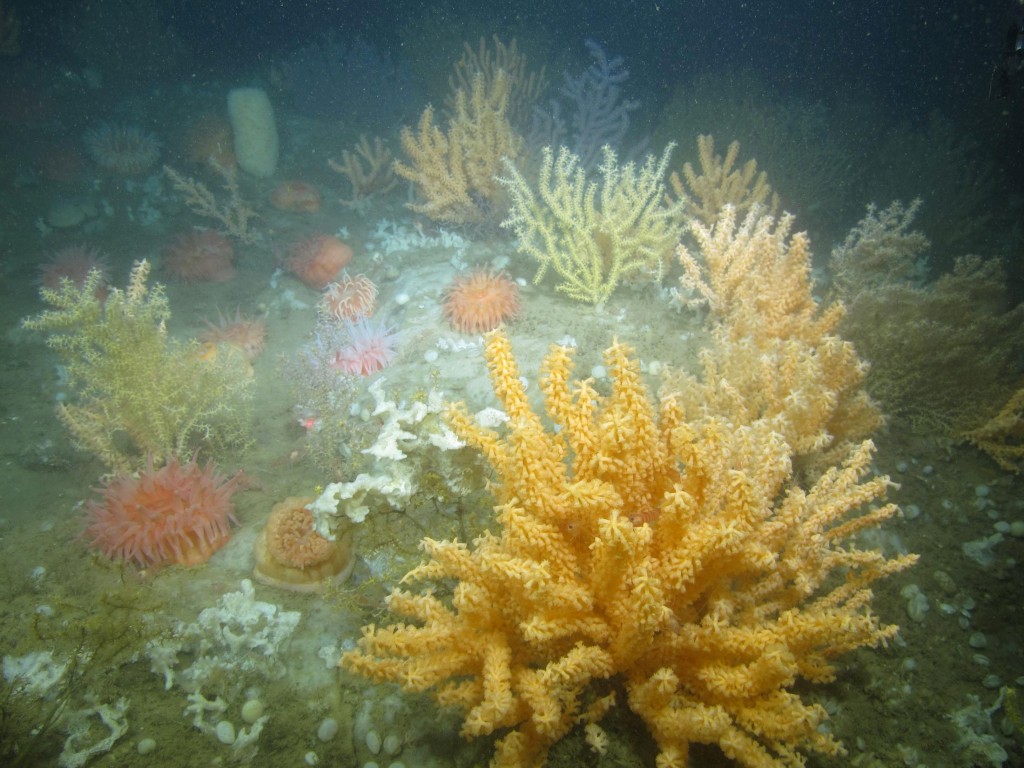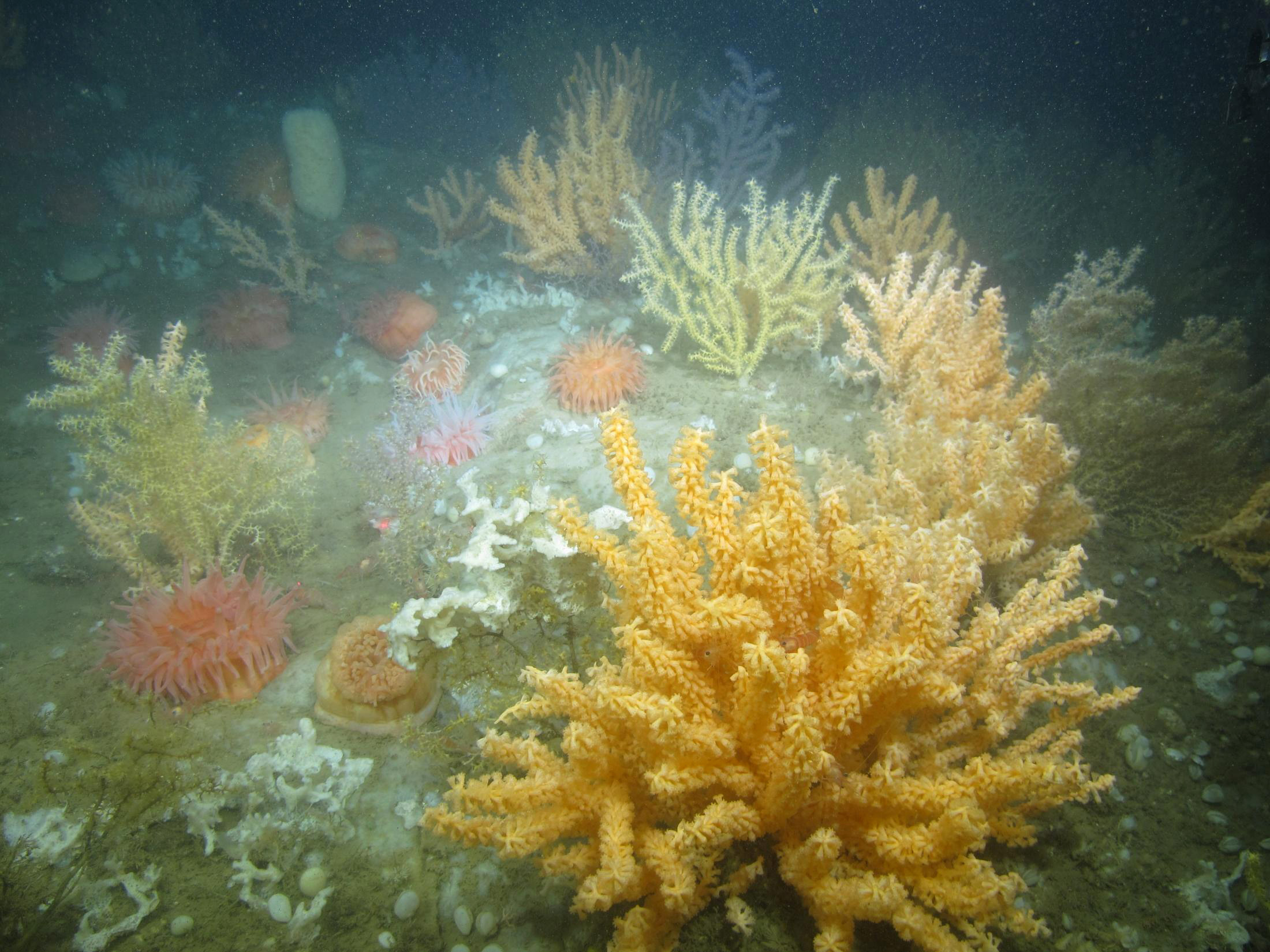
Brilliantly colored gardens of red tree coral (Primnoa), fan coral (Paramuricea), and multiple species of sponge grow on underwater ridges and along the walls of box canyons deep in the cold waters of the Gulf of Maine.
The question is, “Who knew?”
While many people are familiar with the colorful types of soft corals that are formed from organic material and are found in shallow, well-lit tropical waters, the deep water varieties that exist along both U.S. coasts, and as far north as Alaska, are not commonly observed.
There are stories dating back to the 1800s of fishermen in the Gulf of Maine recovering pieces of coral that had snagged on their gear, but until recently there were only educated guesses as to the actual extent of the coral, and where it might be located.
UConn’s Peter Auster and his colleagues from the University of Maine and the National Marine Fisheries Service spent part of the last three summers aboard UConn’s Research Vessel (RV) Connecticut searching for these deep sea coral communities. Using remotely controlled underwater vehicles and sophisticated data telemetry and video technologies, they literally ‘walked’ their cameras along the ocean floor in search of their elusive quarry.
Auster is research professor emeritus of marine sciences at UConn’s Avery Point Campus, and science director of the Northeast Underwater Research Technology & Education Center (NURTEC). He explains that, based on historical accounts, marine scientists infer that the deep sea corals remaining today are vestiges of communities that were much more widely distributed in the past.
“Deep sea coral communities are sensitive to environmental changes and vulnerable to human activities such as commercial fishing and oil and gas exploration. Federal legislation acknowledges these problems and the need for conservation,” Auster says. “In fact, the United Nations General Assembly has passed several resolutions that are focused on this deep sea coral and other ecologically sensitive communities because of their vulnerability to outside forces. That’s why we set out to find what might still be hidden in the Gulf of Maine.”
In the summer of 2013, the scientific team initially identified three distinct areas containing some high-density patches of coral. In the second year, when they revisited those same general areas with a more maneuverable underwater vehicle, they found some spectacular coral gardens. This past summer, they added two more sites to their list.
The five distinct and relatively small coral areas are widely spaced across the Gulf. They boast formations that extend anywhere from about 25 to 40 feet high at depths of over 600 feet. They are not only surprising in their size, according to Auster, but are “unbelievably complex and beautiful.”
The Gulf stretches from the western tip of Nova Scotia all the way to Cape Cod, Mass., and spans 36,000 square miles. It is home to more than 2,200 species of marine life and birds, and encompasses Georges Bank, an immense shoal that for generations was one of the world’s richest commercial fishing grounds.


Finding something so rare in a region this vast is no easy task, but Auster welcomed the challenge. He was confident that using all of the available seafloor maps, research from other regions, and the latest generation of underwater vehicles – as well as the sophisticated maneuvering ability of the RV Connecticut – the hunt would be productive.
He notes that he and several colleagues had begun looking for deep sea coral communities in the Gulf as far back as 2002. “We did find a few limited sites,” he says, “but nothing like what we’ve found in the past few years.”
The extent of the recent discoveries surprised even this seasoned researcher. “It’s amazing we have been able to make these types of discoveries in one of the most well-studied parts of the global ocean, and after a bit more than half a century of people diving with submersibles in this region,” Auster says. “I’ve been doing this kind of work for over 30 years, and I was stunned when we first found these rock walls literally blanketed in coral.”
Corals are colonial animals with single or multiple polyps, each with a mouth surrounded by tentacles and an interconnecting framework supported by flexible exoskeletons. These deep sea forms tend to be slow growing, long lived, and are very sensitive to environmental disturbances.
Identifying the existence of coral gardens will not only inform marine scientists about the ecological role the coral communities play in mediating patterns of biodiversity in deep continental shelf habitats, the knowledge will also be used by the New England Fishery Management Council and the National Oceanic and Atmospheric Administration (NOAA) as they develop a plan for conservation of deep sea corals in order to minimize impacts from fishing.
The research was funded through the Federal Deep Sea Coral Research and Technology Program sponsored by NOAA. The goal is the conservation and sustainable use of marine resources.





